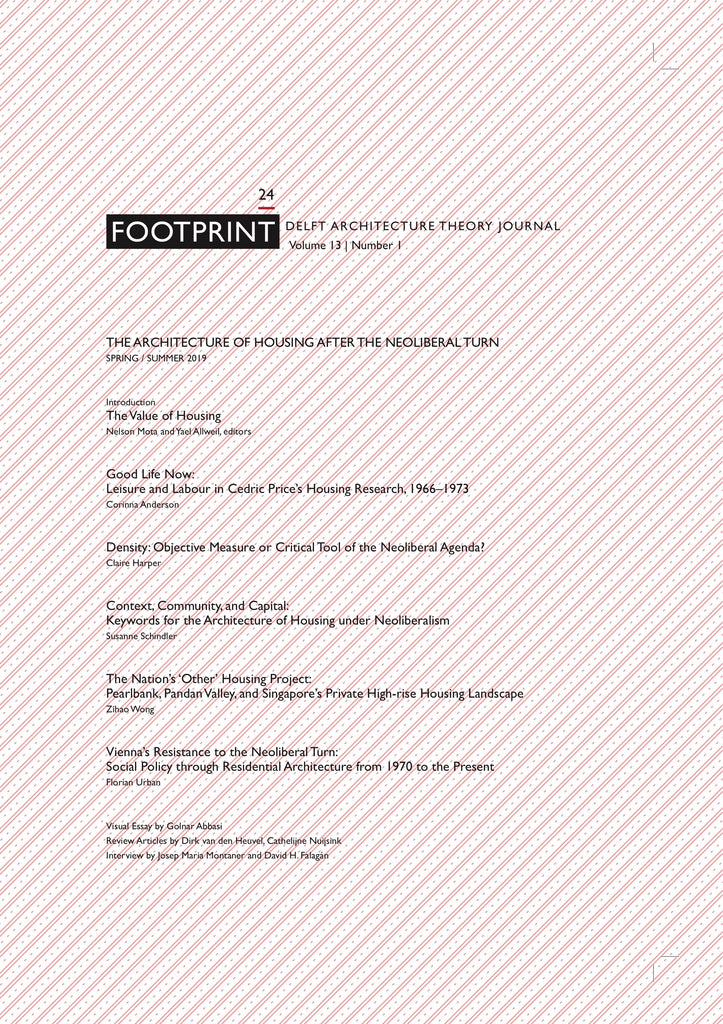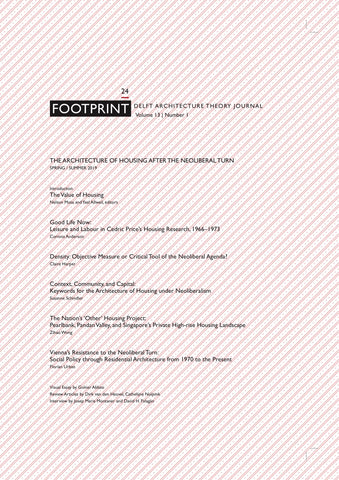Your cart is currently empty!
Architecture
Footprint 24 The Architecture of Housing after the Neoliberal Turn
+++ +++
+++Nelson Mota, Yael Allweil [eds.]+++
978-94-92852-08-3
Ania Molenda
164
19 x 25.7 cm / 7.48 x 10.12 inches
paperback
Release date: Spring/Summer 2019
English
Copy editor: Heleen Schröder
Published in cooperation with Architecture Theory Chair (TU Delft) and Stichting Footprint: http://footprint.tudelft.nl/
For a subscription: Bruil & Van de Staaij
+++
This issue includes research articles by Corinna Anderson, Claire Harper, Susanne Schindler, Zihao Wong and Florian Urban, and review articles by Dirk van den Heuvel and Cathelijne Nuijsink. This issue also includes a visual essay by Golnar Abbasi and an interview to Josep Maria Montaner by David H. Falagán.
In 1872 Friedrich Engels’s The Housing Question indicated the societal relevance of workers’ housing provision, raising it to a prominent position in the apparatus of the capitalist mode of production. Eventually, in the interwar period, housing for workers had a key role in re-organising class relations and the city, and in shaping modernist architecture. With the reconstruction of Europe in the aftermath of World War II, housing gained momentum as a key factor to secure the social reproduction of labour. The ‘social project’ of welfare state politics identified housing as one of its main pillars and attracted the engagement and creativity of talented professionals in private offices and public housing departments. The postwar focus on housing triggered the emergence of theories on the architecture of dwelling as a social and spatial practice, which proliferated and occupied the main stage in venues such as the CIAM, UIA Congresses, Team 10 meetings, Delos Symposia and so on.
From the 1980s until the first decade of the twenty-first century there was a sharp decline in the visibility of housing and the architecture of dwelling as mainstream topics in architectural scholarship, media and education. Furthermore, with the exception of a few events (e.g. the Barcelona Olympics, the IBA Berlin, or the harbour conversions of Amsterdam and Hamburg), over these three decades, mass housing projects have seldom made it to the portfolio of notable practicing architects and were rarely included in architectural publications. However, since the global economic downturn of 2008, housing and the architecture of dwelling have gained again widespread notoriety. Scholarship on the entwined relationship between the current housing crisis and the hegemony of the neoliberal economic system and its associated corporate monopolies is now gaining momentum (Jack Self (2014), Reinhold Martin et al. (2015), Madden & Marcuse (2016)).
Neoliberal governance transferred the responsibility for affordable housing provision to the markets. The collusion of government (de-) regulation, market ideology, and the architectural desertion of housing theory stalled the production of innovations in the architecture of dwelling and prompted a crisis in the mechanisms producing and distributing housing solutions for different publics. We are now facing a threat to the creation of safe, resilient and inclusive cities and human settlements, one of the goals of the United Nations’ New Urban Agenda. Now, to mitigate the growing social unrest created by the current housing crisis, supra-national organisations (e.g. NGOs, the UN, the World Bank) as well as national and regional governments face a paradox: the survival of neoliberalism depends in part on intensifying the intervention of the state in affordable housing provision.
In Footprint 24 we want to discuss the implications of the neoliberal housing paradox for the discipline of architecture. Re-theorising the architecture of dwelling is urgent to critically assess past and current experiences and provide insights to engage with future challenges. Can this be an opportunity to reiterate the social relevance of housing and thus attract the best planners, urban designers and architects to contribute innovative solutions to accommodate the ‘great number’? Which possibilities are there to engage the architecture discipline in the housing question once more? Which critical approaches to the housing issue after the neoliberal turn can be used to re-conceptualise the architecture of dwelling in a post-neoliberal period? This issue of Footprint aims at examining how the housing policies that unfolded since the 1980s have contributed to re-theorise the architecture of dwelling as a social and spatial practice.
€25.00
Footprint 24 The Architecture of Housing after the Neoliberal Turn
€25.00
Architecture / Bookazines / Series / Theory / Urbanism
978-94-92852-08-3
Ania Molenda
164
19 x 25.7 cm / 7.48 x 10.12 inches
paperback
Release date: Spring/Summer 2019
English
Copy editor: Heleen Schröder
Published in cooperation with Architecture Theory Chair (TU Delft) and Stichting Footprint: http://footprint.tudelft.nl/
For a subscription: Bruil & Van de Staaij
This issue includes research articles by Corinna Anderson, Claire Harper, Susanne Schindler, Zihao Wong and Florian Urban, and review articles by Dirk van den Heuvel and Cathelijne Nuijsink. This issue also includes a visual essay by Golnar Abbasi and an interview to Josep Maria Montaner by David H. Falagán.
In 1872 Friedrich Engels’s The Housing Question indicated the societal relevance of workers’ housing provision, raising it to a prominent position in the apparatus of the capitalist mode of production. Eventually, in the interwar period, housing for workers had a key role in re-organising class relations and the city, and in shaping modernist architecture. With the reconstruction of Europe in the aftermath of World War II, housing gained momentum as a key factor to secure the social reproduction of labour. The ‘social project’ of welfare state politics identified housing as one of its main pillars and attracted the engagement and creativity of talented professionals in private offices and public housing departments. The postwar focus on housing triggered the emergence of theories on the architecture of dwelling as a social and spatial practice, which proliferated and occupied the main stage in venues such as the CIAM, UIA Congresses, Team 10 meetings, Delos Symposia and so on.
From the 1980s until the first decade of the twenty-first century there was a sharp decline in the visibility of housing and the architecture of dwelling as mainstream topics in architectural scholarship, media and education. Furthermore, with the exception of a few events (e.g. the Barcelona Olympics, the IBA Berlin, or the harbour conversions of Amsterdam and Hamburg), over these three decades, mass housing projects have seldom made it to the portfolio of notable practicing architects and were rarely included in architectural publications. However, since the global economic downturn of 2008, housing and the architecture of dwelling have gained again widespread notoriety. Scholarship on the entwined relationship between the current housing crisis and the hegemony of the neoliberal economic system and its associated corporate monopolies is now gaining momentum (Jack Self (2014), Reinhold Martin et al. (2015), Madden & Marcuse (2016)).
Neoliberal governance transferred the responsibility for affordable housing provision to the markets. The collusion of government (de-) regulation, market ideology, and the architectural desertion of housing theory stalled the production of innovations in the architecture of dwelling and prompted a crisis in the mechanisms producing and distributing housing solutions for different publics. We are now facing a threat to the creation of safe, resilient and inclusive cities and human settlements, one of the goals of the United Nations’ New Urban Agenda. Now, to mitigate the growing social unrest created by the current housing crisis, supra-national organisations (e.g. NGOs, the UN, the World Bank) as well as national and regional governments face a paradox: the survival of neoliberalism depends in part on intensifying the intervention of the state in affordable housing provision.
In Footprint 24 we want to discuss the implications of the neoliberal housing paradox for the discipline of architecture. Re-theorising the architecture of dwelling is urgent to critically assess past and current experiences and provide insights to engage with future challenges. Can this be an opportunity to reiterate the social relevance of housing and thus attract the best planners, urban designers and architects to contribute innovative solutions to accommodate the ‘great number’? Which possibilities are there to engage the architecture discipline in the housing question once more? Which critical approaches to the housing issue after the neoliberal turn can be used to re-conceptualise the architecture of dwelling in a post-neoliberal period? This issue of Footprint aims at examining how the housing policies that unfolded since the 1980s have contributed to re-theorise the architecture of dwelling as a social and spatial practice.



